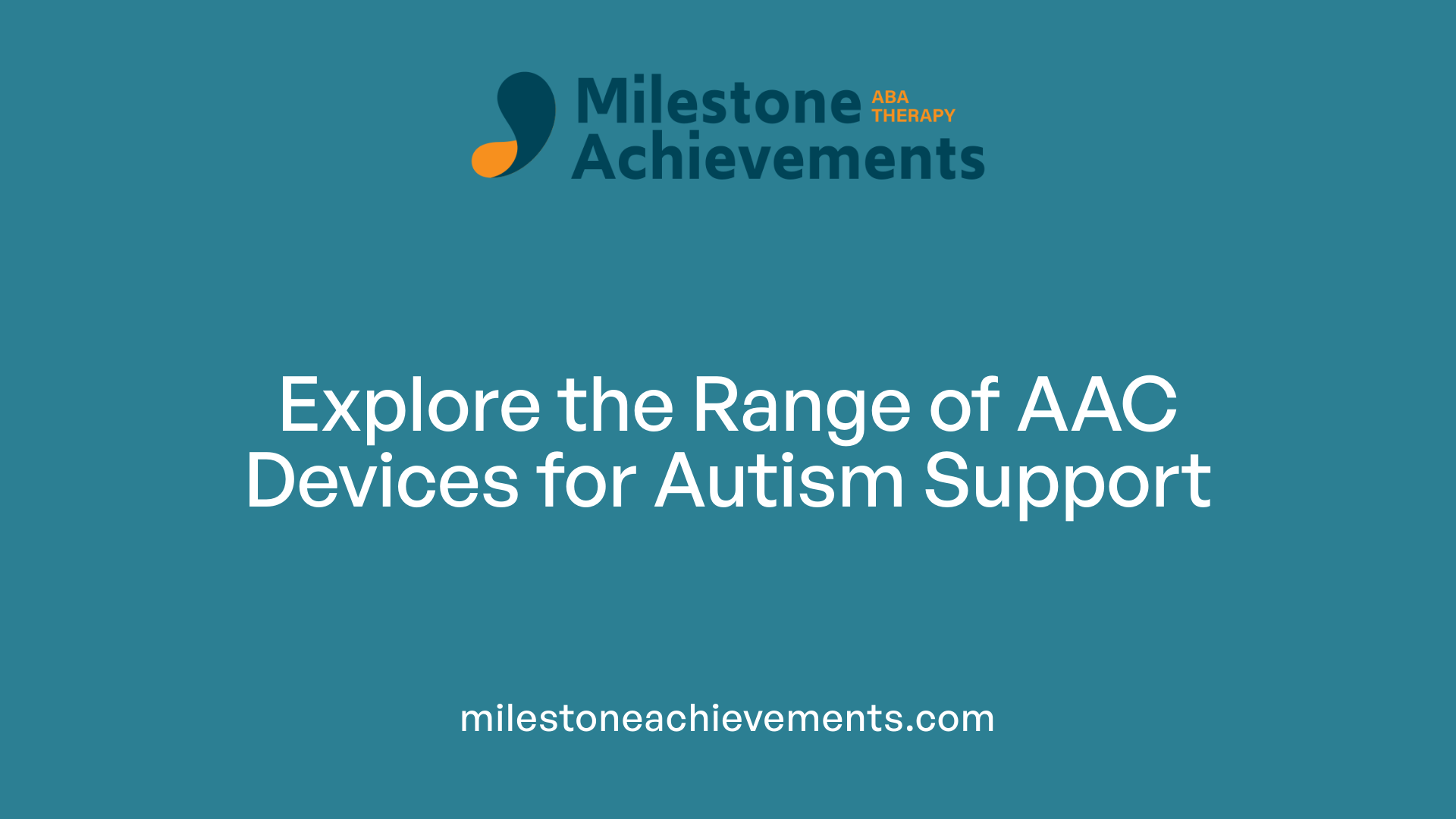
What Is an AAC Device for Autism?
Unlocking Communication: How AAC Devices Transform Lives in Autism
Understanding AAC Devices and Their Impact
Augmentative and Alternative Communication (AAC) devices are essential tools that support individuals with autism spectrum disorder (ASD) in expressing themselves effectively. These devices encompass a broad range of tools, from simple gestures to advanced electronic systems, and play a crucial role in enhancing communication, independence, and social participation among autistic individuals.
What Are AAC Devices and How Do They Function?
What are AAC (Augmentative and Alternative Communication) devices?
AAC devices are specialized tools and systems designed to help individuals with speech or language difficulties communicate more effectively. These devices include a wide range of methods from simple gestures to advanced electronic systems.
Aided AAC methods involve physical tools like communication boards, picture books, or electronic speech-generating devices. These tools can display pictures, symbols, words, or text to aid communication. Unassisted or unaided methods rely solely on the person's body, such as gestures, facial expressions, or sign language.
AAC devices are suitable for users of all ages, from young children to adults. They are customizable to meet individual needs, taking into account physical abilities and language skills. Introducing AAC systems often involves professionals like speech-language pathologists who help select appropriate tools, teach usage, and ensure integration into daily life.
Using AAC supports various aspects of life, including social participation, independence, safety, and overall quality of life. Importantly, research shows that AAC devices do not hinder speech development. Instead, they can promote language learning, literacy, and confidence in communication.
Different forms of AAC: unaided and aided methods
AAC methods are typically divided into two categories:
- Unaided AAC: These rely solely on the person's body for communication. Examples include gestures, facial expressions, body language, vocalizations, and sign languages such as American Sign Language (ASL).
- Aided AAC: These involve external tools or devices. Common examples are picture exchange communication systems (PECS), communication boards, tablets with speech software, and dedicated speech-generating devices.
Components of AAC devices, including visual, speech, and text options
AAC devices incorporate various components to support effective communication:
| Component Type | Examples | Purpose and Features |
|---|---|---|
| Visual supports | Pictures, icons, symbols, communication boards | Help users express ideas visually, suitable for those who learn visually or have limited motor skills |
| Speech output | Voice output on devices, text-to-speech apps | Generate spoken words or phrases to communicate in real time |
| Text options | Keyboard input, spelling guides | Support literacy and spelling, enabling users to compose messages |
Many modern AAC devices combine these elements. For instance, a tablet app like Proloquo2Go uses symbol-based images, spoken output, and text entry to create a flexible communication system.
In summary, AAC devices encompass a broad spectrum of tools designed to support and enhance communication for individuals with speech challenges. Their adaptability, combined with professional guidance, makes them essential resources in empowering effective interaction and participation in daily activities.
Types of AAC Devices Suitable for Individuals with Autism
 AAC, or Augmentative and Alternative Communication, offers a wide range of devices to support communication for individuals with autism. These devices range from simple picture systems to sophisticated electronic tools.
AAC, or Augmentative and Alternative Communication, offers a wide range of devices to support communication for individuals with autism. These devices range from simple picture systems to sophisticated electronic tools.
At the most basic level, no-tech and low-tech AAC options include picture exchange systems, communication boards, and gestures. These provide visual cues or symbols that help individuals express needs or wants without speaking.
Moving into electronic options, high-tech devices such as speech-generating devices (SGDs) are popular among users with more complex needs. Devices like NovaChat by PRC-Saltillo, Tobii Dynavox products, and tablets equipped with specialized apps like Proloquo2Go or TouchChat are examples. These devices feature customizable vocabularies, organized interfaces, and multiple access methods, including switch access and eye gaze, enabling varied motor abilities.
Features of these advanced tools include dynamic screens, the ability to add or delete icons, and text-to-speech capabilities. For some individuals, especially those with limited motor control, eye gaze technology allows communication without physical touch.
Choosing the right AAC device depends heavily on the individual’s motor skills, cognitive abilities, and specific communication needs. For example, a user with fine motor challenges might benefit from eye gaze technology, while another might use a tablet with a simple button interface.
Assessment by a speech-language pathologist helps determine the most appropriate device, ensuring it aligns with the user's current skills and potential for growth.
Overall, AAC options are designed to be flexible and personalized, ensuring each person with autism receives effective communication support tailored to their abilities and goals.
How AAC Devices Enhance Communication and Support Development

How do AAC devices support communication for autistic individuals?
AAC devices are essential tools that help autistic people express their needs, thoughts, and emotions when speech is limited or absent. These devices include a variety of communication options, such as speech-generating devices, symbol-based apps, picture boards, and gestures. They are often designed to be user-friendly and highly customizable, allowing individuals to adapt them to their motor skills and language level.
These systems promote independence by enabling users to communicate across different settings, whether at home, school, or in the community. They also support social interaction, making it easier for autistic individuals to connect with others, participate in conversations, and build relationships.
Research over the past decades confirms that AAC devices do not hinder speech development. On the contrary, they often support and enhance language skills. Features such as auditory feedback, visual supports, and interactive interfaces help improve receptive (understanding) and expressive (speaking or gesturing) language abilities.
AAC solutions benefit users of all ages. For young children, early use can foster language growth and reduce frustration. For adults, AAC can sustain ongoing communication and social participation. Overall, these devices are powerful tools that empower autistic individuals, helping them become more independent, confident, and socially engaged.
Benefits of AAC Devices in Childhood Development
What are the benefits of using AAC devices for children with autism?
AAC devices play a crucial role in supporting children with autism by significantly enhancing their ability to communicate. These tools provide alternative ways for children to express their needs, feelings, and thoughts, which can be challenging with speech impairments.
One major advantage is the improvement in communication skills. AAC systems, such as picture exchange communication systems (PECS) or speech-generating devices, help children initiate interactions and respond more effectively in social settings. This increased ability to connect can lead to better social participation and greater independence.
Customization options are an important feature of AAC devices. They can be tailored to each child’s abilities and preferences. Access methods include touch screens, eye gaze technology, switches, or head pointing, allowing children with varying motor skills to use the devices comfortably. These options help make communication more accessible and natural.
Support for speech and language learning is another significant benefit. AAC devices can serve as teaching tools, encouraging verbal imitation and reinforcing vocabulary. Over time, many children may develop improved spoken language skills through consistent use of AAC, as it supports both receptive and expressive language development.
The use of AAC also fosters overall development, including cognitive skills and emotional regulation. It provides a platform for children to participate actively in classroom activities, family conversations, and social events.
While benefits can vary depending on individual needs and implementation consistency, research consistently shows that AAC enhances communication, social participation, and developmental progress in children with autism. Effective use of these tools requires individualized assessment, ongoing support from professionals, and active involvement from caregivers to optimize outcomes.
Supporting Speech and Language Growth with AAC Technologies

How AAC aids in vocabulary building and functional communication
Augmentative and Alternative Communication (AAC) devices play a vital role in helping individuals with autism expand their vocabulary and develop practical communication skills. These tools, which include visual symbols, speech-generating devices, and written or picture-based communication boards, enable users to express basic needs, desires, and thoughts effectively. By providing consistent access to symbols and words, AAC facilitates learning new vocabulary within meaningful contexts and encourages functional communication in everyday situations.
AAC systems are often customized to suit individual abilities and preferences. For young children or non-verbal individuals, simple picture exchanges (like PECS or Picture Exchange Communication System) can serve as initial steps towards more complex language use. As users become more proficient, they can transition to electronic devices or apps that support dynamic vocabulary and sentence formation, making communication more natural and comprehensive.
The potential of AAC to serve as a bridge to verbal speech
Contrary to some misconceptions, AAC does not replace or hinder verbal language development. Instead, it can act as a bridge, supporting and encouraging speech in many cases. By providing a reliable communication method, AAC reduces frustration, which often leads to challenging behaviors, and boosts motivation to engage socially.
Research shows that early AAC intervention can prepare individuals for verbal speech by reinforcing language concepts, improving receptive language skills, and fostering confidence in communication. Certain devices, especially those with voice output, help users associate symbols with spoken words, gradually strengthening their verbal skills. Many individuals who begin with AAC go on to develop spoken language, with AAC serving as a supportive tool rather than an alternative.
Research evidence supporting AAC's role in language development
Extensive research underscores the positive impact of AAC on language growth in children and adults with autism. Studies reveal that users who incorporate AAC early in their development often experience gains in receptive and expressive language skills. Importantly, AAC usage has been linked to increased social interaction, better understanding of language, and greater independence.
For example, research indicates that incorporating AAC strategies into comprehensive intervention plans enhances not only communication but also reduces frustration-related behaviors. Moreover, AAC devices providing visual cues can be especially beneficial, given many autistic individuals' preference for processing visual information.
Overall, the evidence affirms that AAC is a valuable tool for fostering language development, supporting social participation, and improving quality of life for individuals with autism.
When and Why to Consider AAC for Autism
When and why should one consider using an AAC device for autism?
Deciding when to introduce an augmentative and alternative communication (AAC) device is an important step in supporting individuals with autism. Often, it is recommended when traditional speech therapy results in limited progress, especially if the person’s receptive language — understanding of language — exceeds their expressive language, meaning they understand more than they can verbally express.
For children and adults whose speech development plateaus or remains very limited over time, AAC can provide a valuable means of communication. It allows them to express needs, thoughts, and emotions more effectively, reducing frustration and enhancing social interactions.
Motor-speech challenges, such as apraxia or dysarthria, can also make spoken communication difficult or impossible. In such cases, AAC systems, whether gesture-based, symbol-based, or electronic, help bypass speech—supporting communication despite motor difficulties.
Professional guidance from speech-language pathologists and other specialists is crucial in selecting the right AAC system. These experts conduct assessments to understand an individual's current communication skills, motor abilities, and environment, helping to tailor the most suitable tools.
AAC devices come in various forms, including unaided methods like gestures and sign language, and aided methods such as communication boards, picture exchange systems like PECS, and electronic devices like tablets with speech-generating apps.
Using AAC can promote independence, foster social participation, and improve quality of life for autistic individuals of all ages. Early adoption and consistent use often lead to better outcomes, supporting the development of functional communication skills that can grow and adapt over time.
Maximizing Effectiveness with Best Practices and Professional Support

What are best practices for using AAC devices effectively?
Implementing AAC effectively requires careful attention to personalized needs. An initial assessment by professionals, such as speech-language pathologists, helps determine the most suitable AAC system tailored to the individual’s motor, cognitive, and sensory abilities. This customization might involve selecting devices with larger screens, simplified interfaces, or specific access methods like eye gaze or switch activation.
Consistent modeling is vital. Caregivers and educators should regularly demonstrate how to use the AAC device during daily activities. By integrating AAC into routines—such as mealtime, play, or social interactions—users gain familiarity and confidence in spontaneous communication.
Training plays a crucial role. Family members, teachers, and peers must learn how to support and encourage AAC use. This includes understanding device functions, prompting use in appropriate moments, and responding positively to communication attempts.
Setting practical goals is equally important. Focus on functional language that addresses real-life situations—such as requesting, greeting, or commenting—rather than just device operation. These goals promote meaningful language growth and social integration.
Creating a supportive environment involves providing ample opportunities for spontaneous communication. This can be facilitated by arranging engaging activities, using social stories, or incorporating video modeling.
Monitoring progress through data collection and regular review helps refine AAC strategies. Collaborating with speech-language professionals ensures that use of the device aligns with evolving communication needs.
Overall, a combination of individualized assessment, ongoing modeling, partner training, goal-oriented practices, and professional support significantly enhances the effectiveness of AAC systems, fostering independence and enriching social connections for individuals with autism.
The Role of Speech-Language Pathologists in AAC Implementation

What role do speech-language pathologists play in implementing AAC solutions?
Speech-language pathologists (SLPs) are essential in helping individuals with autism and other speech or language difficulties effectively communicate using augmentative and alternative communication (AAC) tools. Their primary responsibility is to assess each person’s unique communication needs, strengths, and environment to select the most suitable AAC system.
SLPs work closely with families, educators, and other professionals to develop personalized AAC interventions. This collaborative approach ensures that the chosen tools support functional communication in different settings, whether at home, school, or in the community.
Once an AAC system is selected, SLPs provide hands-on training and coaching for users and their communication partners. This training includes instructions on how to operate devices or apps, interpret symbols, and incorporate AAC into daily routines. They teach both aided methods, like speech-generating devices and communication boards, and unaided methods, such as gestures and sign language.
Monitoring progress is another vital role for SLPs. They regularly evaluate how well the individual is using the AAC system, troubleshoot any technical or practical issues that arise, and make necessary adjustments. Over time, SLPs adapt AAC strategies and devices to reflect the evolving needs and skills of the user.
Through assessment, customized intervention, training, and ongoing support, speech-language pathologists help maximize communication outcomes. Their work empowers individuals with autism to become more independent, build social connections, and improve overall quality of life through effective use of AAC technologies and strategies.
Assistive Technology Options for Communication in Autism
Are there assistive technology options for communication support in autism?
Yes, there are many tools and devices designed to support communication for individuals with autism. These options range from simple visual supports to sophisticated electronic devices.
Electronic speech-generating devices (SGDs) are commonly used to aid speech and language. These include tablets, smartphones, and dedicated communication devices equipped with specialized apps like Proloquo2Go. These apps provide symbol-based and text-based communication, allowing users to express their thoughts, needs, and emotions effectively.
Alongside electronic tools, visual supports such as picture schedules, social stories, and communication boards help reinforce understanding and facilitate social interactions. These low- and mid-tech options are often customized to meet an individual’s specific needs.
Devices and tools can be categorized as low-tech, mid-tech, and high-tech, depending on their complexity and functionality. For example:
| Technology Type | Examples | Benefits |
|---|---|---|
| No-tech | Gestures, facial expressions, pointing | No special equipment needed; easy to adapt in daily routines |
| Low-tech | Picture schedules, communication boards | Visual clarity, easy to modify, affordable |
| Mid-tech | Simple electronic devices, single-message speech boxes | Portable, quick messaging |
| High-tech | Tablets with dynamic communication apps, speech-generating devices | Versatile, customizable, supports complex communication |
Personalized interventions using these tools can significantly improve communication skills, foster independence, and promote social participation. The choice of tools should be tailored to the individual’s current abilities and preferences, often with input from speech-language pathologists, occupational therapists, and caregivers.
Research indicates that assistive technology does not hinder speech development; rather, it can enhance verbal and non-verbal communication skills. It helps users navigate social situations comfortably, express their needs, and build confidence.
In summary, the array of assistive technologies available supports individuals with autism across all ages. These tools promote not only communication but also greater autonomy and inclusion in everyday activities.
Empowering Communication Through Technology
AAC devices represent a vital resource in the journey toward effective communication for individuals with autism. As technology continues to advance, these tools become more accessible, user-friendly, and customizable, opening new doors for social engagement, independence, and personal growth. Collaboration among families, educators, therapists, and professionals is essential to tailor AAC solutions that best meet each individual's unique needs. When integrated properly, AAC devices can dramatically improve quality of life, enabling autistic individuals to connect more meaningfully with the world around them and confidently express themselves in a variety of settings.
References
- What is Augmentative and Alternative Communication and how can ...
- Technology and Autism
- AAC Devices: What They Are and How You Can Get One For Your ...
- Why AAC? - The Center for AAC & Autism
- The Most Popular AAC Devices | TherapyWorks
- Augmentative and Alternative Communication (AAC) - ASHA
- How AAC devices for autism empower communication - Lingraphica
- [PDF] Autism and Augmentative Alternative Communication


Partner with us on your child's journey
Milestone Achievements offers evidence-based ABA therapy to help children with autism reach their full potential. Together we’ll set meaningful goals and celebrate progress every step of the way.
Start ABA Services Today


